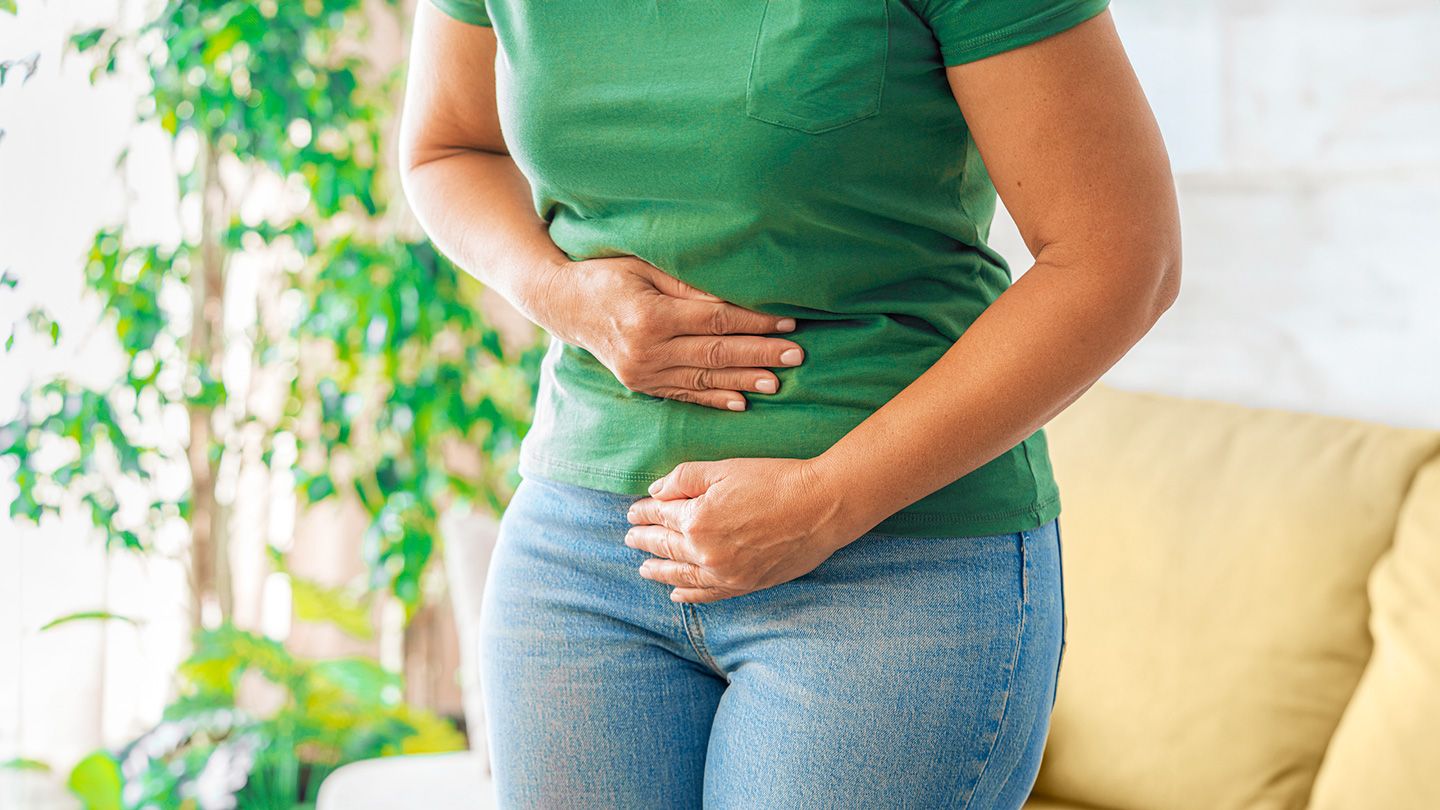Pancolitis (also called widespread or extensive colitis) is a chronic condition that causes inflammation in the entire colon (large intestine). It’s considered a more severe form of ulcerative colitis (UC) based on the extent of UC in the colon.e60dc2a1-f33c-4a05-9b50-8e3e8e5976296c6f3a4b-a255-41c7-b4ff-33fb27fe0435 Commonly referred to as UC pancolitis, symptoms often include abdominal pain, diarrhea, fatigue, and weight loss, among others.e60dc2a1-f33c-4a05-9b50-8e3e8e5976294e128c39-ba16-4eef-b14f-0125c72bfd49 The condition is most often treated with medication, lifestyle changes, and sometimes surgery.e60dc2a1-f33c-4a05-9b50-8e3e8e597629c9648390-3a2c-4c42-adef-faa9c9239956
Signs and Symptoms of UC Pancolitis Symptoms UC pancolitis symptoms can be more severe than typical UC symptoms and include the following:e60dc2a1-f33c-4a05-9b50-8e3e8e59762926edfd5d-0f58-4fa6-aa65-36f2b3737de1 Having more than six bowel movements a day Seeing blood in stool with most bowel movements Nausea or vomiting Other common colitis signs and symptoms include:e60dc2a1-f33c-4a05-9b50-8e3e8e597629cde2a9e5-06c2-4a68-b876-535579319611e60dc2a1-f33c-4a05-9b50-8e3e8e5976297e149a7e-1512-4d69-b590-32ad6b79de8f Mucus or pus in stool Abdominal cramps and pain Tenesmus (constant urge to have a bowel movement) Sudden, urgent need to have a bowel movement Weight loss Fatigue Fever
Causes of UC Pancolitis Causes Although the exact causes of UC pancolitis (and UC in general) aren’t well-understood, researchers believe UC may be caused by factors including:e60dc2a1-f33c-4a05-9b50-8e3e8e597629be76d53a-e89c-45c4-a5ac-5db9d7a6285b Genetics Abnormal immune system function Differences in gut bacteria (the gut microbiome) Environmental factors
How Is UC Pancolitis Diagnosed? Diagnosis The only way to definitively diagnose UC pancolitis is by performing a biopsy during an endoscopic procedure. Other tests can tell you how severe your condition is and check for complications.e60dc2a1-f33c-4a05-9b50-8e3e8e5976293b7d5dd7-ca5a-430f-b76e-beb969e02317 To help diagnose UC pancolitis, your provider may order the following tests:e60dc2a1-f33c-4a05-9b50-8e3e8e59762996ac54a3-3666-4430-bf16-26e215c68941 Colonoscopy Typically done under conscious sedation anesthesia, this procedure involves inserting a camera mounted on a thin, flexible tube into the rectum. This allows your provider to see any inflammation in the colon and take tissue samples for biopsy. Flexible sigmoidoscopy Similar to a colonoscopy, this procedure uses a camera on a thin tube, but in this procedure, the provider only looks at the rectum and lower end of the colon (the sigmoid colon). This test is most often used if there is severe inflammation in the colon. Blood tests Blood tests can check for anemia (a lack of red blood cells which carry oxygen throughout your body), infection, and inflammation. Stool tests Stool samples containing white blood cells or specific proteins can indicate UC, and these tests can also rule out infections that can also cause pancolitis and other conditions. Imaging To identify possible complications and levels of inflammation, you may need imaging tests such as an X-ray, computed tomography (CT) scan, CT enterography, or magnetic resonance enterography.
Treatment and Medication Options for UC Pancolitis Treatment UC pancolitis treatment depends on how severe it is, and can involve medications, surgery, and lifestyle changes.e60dc2a1-f33c-4a05-9b50-8e3e8e59762946e89178-a931-4d2f-89bf-c6e5b457a440 Medication Options Medications to treat UC pancolitis target inflammation, immune system dysfunction, and symptom relief. They may include:e60dc2a1-f33c-4a05-9b50-8e3e8e5976296f32ca18-5f93-4330-9162-fa73351f4697 Anti-Inflammatory agents These medications are typically tried first if the disease is mild.e60dc2a1-f33c-4a05-9b50-8e3e8e5976293673494f-4845-435a-a5d7-fecb88146c7a They include oral 5-aminosalicylates like sulfasalazine (Azulfidine) and mesalamine (Delzicol, Lialda) and corticosteroids like prednisone (Deltasone) and budesonide (Entocort EC). Immunomodulators These medications lower inflammation by suppressing your body’s immune response. They include azathioprine (Azasan, Imuran), mercaptopurine (Purinethol, Purixan), and cyclosporine (Gengraf, Neoral, Sandimmune). Biologics The biologic medication class targets proteins in the immune system to help manage UC symptoms. Biologics include tumor necrosis factor (TNF) inhibitors like infliximab (Remicade), adalimumab (Humira) and golimumab (Simponi), plus other biologics like vedolizumab (Entyvio), ustekinumab (Stelara), mirikizumab (Omvoh), and risankizumab (Skyrizi). They may be used for moderate to severe UC. Small molecules These oral medications reduce inflammation caused by the immune system. They include Janus kinase (JAK) inhibitors like tofacitinib (Xeljanz), upadacitinib (Rinvoq), and filgotinib (Jyseleca), as well as sphingosine-1-phosphate (S1P) receptor modulators like ozanimod (Zeposia). The U.S. Food and Drug Administration (FDA) has issued a warning about a possible increased risk of serious heart issues and cancer after taking tofacitinib. If you take tofacitinib, ask your healthcare provider before making any changes to your treatment plan. Antidiarrheals You may need to take antidiarrheal medications, like loperamide (Imodium A-D), in some cases. You should only take them for severe diarrhea with a healthcare provider’s approval to avoid the risk of toxic megacolon (severe inflammation resulting in an enlarged colon), a life-threatening potential complication of UC. Pain relievers For pain, your provider may recommend acetaminophen (Tylenol), but be sure to avoid NSAIDs like ibuprofen (Advil, Motrin IB), and naproxen sodium (Aleve), which can irritate the intestines. Supplements Your provider may recommend iron supplements to prevent anemia if you have ongoing bleeding, and vitamin D and calcium to help prevent bone loss. Talk to your provider before trying any new over-the-counter supplements or medications.e60dc2a1-f33c-4a05-9b50-8e3e8e597629cdb97ed3-ad80-4633-985d-63921ebaec8b During severe flares, you may be treated in the hospital with antibiotics for infection, blood transfusions for severe anemia, and IV fluids for dehydration.e60dc2a1-f33c-4a05-9b50-8e3e8e597629146a8f29-19df-4cc3-82f9-7eb49ea2f6aa
Surgery You may need surgery for severe UC pancolitis if medicines aren’t working well enough for you, or if you have a complication like uncontrolled bleeding or colorectal cancer.e60dc2a1-f33c-4a05-9b50-8e3e8e597629467695d4-8083-430c-a7f6-0146ba02e248 The type of surgery used for UC pancolitis is proctocolectomy (a type of colectomy ). It involves the removal of the colon and rectum.e60dc2a1-f33c-4a05-9b50-8e3e8e5976290a0f3612-15cd-4376-9273-1fdf38292363 When the surgeon removes your colon, they can sometimes add a J-pouch, which connects your small intestine to your anus, allowing you to continue to have bowel movements as usual after surgery. This type of proctocolectomy is called ileoanal anastomosis, or J-pouch surgery.e60dc2a1-f33c-4a05-9b50-8e3e8e5976296799902d-84e0-4b1d-9146-84d82c4b1ca0 If a J-pouch isn’t possible, you may need an ileostomy : an opening in your stomach (stoma) that makes space for the end of your small intestine to poke through. Throughout the day, liquid stool collects in an ostomy pouch — a bag secured around the opening — which you can empty as needed.e60dc2a1-f33c-4a05-9b50-8e3e8e5976294673aeb5-80fa-4ad0-b70f-3c77e1a17f1ae60dc2a1-f33c-4a05-9b50-8e3e8e597629833eced1-20d3-4813-aabd-b027edf59c38 In a slightly different and much less common version of the ileostomy called a Kock pouch, the surgeon places a one-way valve in the stoma. This allows you to access it with a tube when it’s convenient, and you don’t have to wear an ostomy bag.e60dc2a1-f33c-4a05-9b50-8e3e8e59762987b5224c-e4d8-4090-a9cb-0d404fcbba80 Complementary and Integrative Therapies Some people may try complementary and integrative therapies alongside standard treatments for potential symptom relief, and anecdotal claims report some benefits. But there’s not yet enough research to widely recommend any complementary therapy for UC pancolitis.e60dc2a1-f33c-4a05-9b50-8e3e8e59762931753d3b-5738-49fb-902e-edb54d80b430 For example, while some preliminary evidence suggests taking probiotic supplements may be helpful, more research is needed before they can be recommended to people with UC pancolitis.e60dc2a1-f33c-4a05-9b50-8e3e8e597629e5751f12-dcff-40bf-ab2b-2b4a54f37ae0 In fact, the American Gastroenterological Association currently recommends against taking probiotic supplements for digestive disorders like UC due to a lack of evidence of their benefits for this purpose.e60dc2a1-f33c-4a05-9b50-8e3e8e5976299a880069-18e5-4841-93bf-092c7389ba22 Another potential treatment in the early stages of research is fecal transplant , in which a provider inserts a healthy sample of fecal matter into the colon of someone with UC, which may promote growth of good microbes. It is currently offered in clinical trial settings only.e60dc2a1-f33c-4a05-9b50-8e3e8e5976298e9dd9db-5b8b-4716-b0b3-01435d0e9d90
Prevention of UC Pancolitis Prevention While UC pancolitis itself can’t be prevented, you can take steps to prevent flares , like managing stress and avoiding triggers like food and medications that are hard on the intestines, such as NSAIDs. Triggers may vary from person to person. You can work with your provider to determine your triggers.e60dc2a1-f33c-4a05-9b50-8e3e8e597629a56a256a-bf48-48ce-a64e-338f9130d841
Lifestyle Changes for UC Pancolitis Lifestyle Changes Certain lifestyle changes can help you avoid symptom flare-ups. Make Changes to Your Diet Although food likely doesn’t cause UC pancolitis, certain foods may trigger your symptoms. Food triggers often vary from person to person. It can help to keep a running list of foods that prompt symptoms or flares in order to figure out what your triggers are. In the meantime, consider following these dietary tips.e60dc2a1-f33c-4a05-9b50-8e3e8e597629e5302046-8b7f-42cb-ac8d-32336e1afc20 Keep dairy at a minimum. Lactose intolerance (inability to digest milk products properly) is more common in people with IBD. Avoiding dairy may lessen flare-like symptoms. You can also ask your provider about lactose-free milk and dairy products, which may be more easily digestible for you. Eat frequent small meals. Your intestines may be able to handle five or six small meals a day better than fewer, larger meals. Stay hydrated. Drink plenty of water each day (current guidelines recommend 11.5 cups for women and 15.5 cups for men), and try to limit or avoid dehydrating beverages like alcohol and caffeine, which may trigger symptoms in some people.e60dc2a1-f33c-4a05-9b50-8e3e8e5976290604591b-992a-428a-8ccb-605b2c73afdb You may also benefit from speaking with a dietitian to help you decide on the best nutritional choices for you, especially if you’re losing weight or most foods seem to cause symptoms for you.e60dc2a1-f33c-4a05-9b50-8e3e8e597629404cc908-753d-4564-b878-4ff4d607b608 Avoid NSAIDS If you need to treat pain or fever, choose acetaminophen (Tylenol) instead of NSAIDs like ibuprofen (Advil) and naproxen (Aleve). NSAIDs can irritate the intestinal lining and worsen symptoms. Before taking any new medication, check with your provider first.e60dc2a1-f33c-4a05-9b50-8e3e8e597629679adfbf-1176-4381-a8d2-a1f7fbb925fd Manage Stress Stress can worsen symptoms and even trigger flares, which is why it’s important to do your best to manage it. These activities can help curb stress:e60dc2a1-f33c-4a05-9b50-8e3e8e5976290df1f26e-e61f-4257-b9f0-8275e2208f1ee60dc2a1-f33c-4a05-9b50-8e3e8e597629e143375e-4f56-42c5-997b-3f1bcad560aa Try relaxation and meditation . Get at least seven hours of sleep every night. Exercise every day.
How Long Does UC Pancolitis Last? Prognosis and Outlook UC pancolitis is a chronic condition, meaning you need to manage the symptoms for the rest of your life. But with proper treatment and prevention of complications, UC itself is rarely fatal.e60dc2a1-f33c-4a05-9b50-8e3e8e597629d8ee0c8c-b693-4b73-b932-e4b3e080cb17
Complications of UC Pancolitis Complications Inflammation that involves more extensive areas of the colon, such as with pancolitis, can come with a higher risk of colon cancer, which increases over time.e60dc2a1-f33c-4a05-9b50-8e3e8e597629e5a84483-7f62-45a6-b9f7-034b357b1150 Other complications may include:e60dc2a1-f33c-4a05-9b50-8e3e8e597629de4c96ee-0aac-4b01-9b89-1baf800cebdbe60dc2a1-f33c-4a05-9b50-8e3e8e59762957ab8265-929e-4d17-83ec-990c065deb7e Severe rectal bleeding Perforated colon (a break or hole in the colon) Severe dehydration Anemia (low red blood cell count) Osteoporosis (bone loss) Skin, joint, and eye inflammation Toxic megacolon Inability to hold in a bowel movement Sexual dysfunction Pelvic abscess Blood clots
Research and Statistics: Who Has UC Pancolitis? Research and Statistics Pancolitis develops in 14 to 35 percent of people with UC, and northern Europe and North America have the highest prevalence of IBDs as a whole. UC is more common in adults than in children, especially compared with Crohn’s disease, but UC is less common than Crohn’s overall.e60dc2a1-f33c-4a05-9b50-8e3e8e597629f54a31fd-a5f3-4397-80c2-083659b3e456 Up to age 45, women and men develop UC in equal numbers, but after this age, women are up to 32 percent less likely to have it than men.e60dc2a1-f33c-4a05-9b50-8e3e8e597629ba53f141-cc3e-4e20-8290-7ced5ab9a23a
Disparities and Inequities in UC Pancolitis Disparities Current research around disparities and inequities in UC in general is lacking, but some smaller studies have found some differences based on race and ethnicity.e60dc2a1-f33c-4a05-9b50-8e3e8e597629739f6f54-aa3f-4587-95de-5635897388dc For example, one study found non-Hispanic Black individuals with UC had better quality of life and fewer symptoms of depression and anxiety than non-Hispanic white participants. The study authors hypothesized that racial socialization, a process in which people form a sense of their racial identity and learn how to cope with challenges related to race, as well as a strong community support system, may help mitigate stressors on mental health among non-Hispanic Black individuals.e60dc2a1-f33c-4a05-9b50-8e3e8e597629f5e79ddb-5c06-423d-b0c0-a674a1ccb5f6 Historically, non-Hispanic Black people have experienced disparities around IBD care, like a decreased likelihood of getting a needed gastrointestinal (GI) workup for anemia and diarrhea. Prior research has also found Black patients have had worse IBD outcomes, higher hospitalization and readmission rates, longer hospital stays, and more complications after surgery than white patients with IBD.e60dc2a1-f33c-4a05-9b50-8e3e8e597629273112ad-7502-428f-a253-d44e996317a9
Related Conditions of UC Pancolitis Related Conditions Medical conditions that may have similar symptoms to UC pancolitis include:e60dc2a1-f33c-4a05-9b50-8e3e8e597629c3a53b74-30c0-4728-858a-6df7c70bb697e60dc2a1-f33c-4a05-9b50-8e3e8e5976294bf01ee9-527b-4838-ba07-829b25b5bbc9 Crohn’s disease A form of IBD that’s similar to UC, but it can affect any part of the GI tract rather than only the colon Parasitic colitis A form of UC that’s caused by organisms like Entamoeba histolytica Tuberculosis A bacterial infection that most often affects the lungs,e60dc2a1-f33c-4a05-9b50-8e3e8e597629b6fdd0c7-0fdc-4aa4-afd3-e580f79478ad but can also affect the GI tracte60dc2a1-f33c-4a05-9b50-8e3e8e5976298595ab86-70a4-4f04-b5cb-fb8655a65b5b Radiation colitis A form of UC that results from radiotherapy for gynecological, urological, and rectal cancers Colorectal cancer A type of cancer affecting the colon and rectume60dc2a1-f33c-4a05-9b50-8e3e8e597629f7ce87cd-2118-4416-8852-b518da547ee3 Toxic megacolon A rare, life-threatening form of colon disease involving severe inflammation and enlargement of the colone60dc2a1-f33c-4a05-9b50-8e3e8e59762927f7229d-6146-42ff-8cf1-3f5586c4726e Bacterial/viral gastroenteritis An infection caused by bacteria like E. coli , salmonella, and C. difficile , or viruses like cytomegalovirus
Support for People With UC Pancolitis Support Crohn’s & Colitis Foundation The Crohn’s & Colitis Foundation provides a range of virtual and in-person support groups for people with an IBD like UC pancolitis. In these groups, anyone with an IBD and their caregivers can connect, share experiences, and get emotional support. They also offer educational resources, patient programs, and advocacy tools to help people live well with IBD. Connecting to Cure Crohn’s & Colitis Connecting to Cure Crohn’s & Colitis raises funds for IBD research and offers education, support groups, and community events for those with IBD. Their mission is to support patients and families, raise awareness, and help accelerate the search for better treatments and a cure for Crohn’s disease and UC. Girls With Guts Girls With Guts empowers women and nonbinary individuals with IBD or ostomies through virtual groups, retreats, and other resources. They aim to foster connections, help people build confidence, and promote self-advocacy, creating supportive spaces to share experiences and challenge stigma.
The Takeaway Pancolitis is a severe form of ulcerative colitis (UC) involving the entire colon. Often referred to as UC pancolitis, symptoms may include blood and mucus in bowel movements, weight loss, abdominal cramps and pain, nausea and vomiting, and fever, among others. UC pancolitis is treated with medications like biologics, immunomodulators, small molecule drugs, and others. If medications don’t work well enough for you, surgery may be needed.
Resources We Trust Cleveland Clinic: ColitisMayo Clinic: Living With Crohn’s Disease or ColitisCrohn’s & Colitis Foundation: Stress and IBD: Breaking the Vicious CycleCrohn’s & Colitis UK: Flare-Ups With Crohn’s or ColitisCenters for Disease Control and Prevention: Ulcerative Colitis Basics
Read the full article here
Leave a comment




